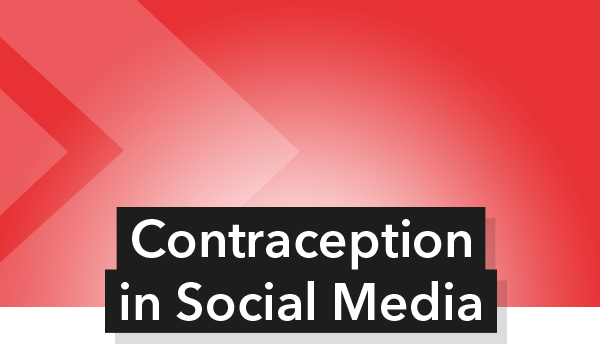This research project is funded by the Federal Centre for Health (BZgA).
The aim of the research project is to work out systematically from a communication science perspective how various contraceptive methods are presented and discussed on central social media platforms in German-speaking areas. Moreover, the quality of information is to be evaluated.
The research focuses on all 15 contraceptive methods, which are presented on sexuality education websites of the Federal Centre for Health (BZgA) (https://www.familienplanung.de/verhuetung/verhuetungsmethoden/):
- The contraceptive pill
- The mini pill (the progestogen-only pill, POP)
- Condom (male)
- The female condom
- Diaphragm
- Hormonal coil
- Hormone sticks (contraceptive implant)
- Contraceptive patch
- FemCap
- Three-month injection (depo)
- Copper IUD
- Coitus interruptus and other unsafe methods
- Vaginal ring
- Symptothermal method (so-called natural family planning NFP)
- Sterilization
Four social media platforms are researched:
- Wikipedia
(Relevance: Wikipedia entries usually appear within the first hits in Google searches.) - YouTube
(Relevance: Most-used social media platform worldwide) - Instagram
(Relevance: In Germany, second most used social media platform among young people behind YouTube.) - TikTok
(Relevance: Social media platform with the highest growth rates worldwide)
Expected gain of knowledge
It is expected to gain a well-based knowledge of how contraception methods are presented and discussed in social media in German-speaking areas closing an existing research gap. The practical relevance for professional advice is obvious: results can be used a) to pick up target groups where they are currently in the discourse on contraception in social media and b) to develop and spread own sexuality education material matching best the target group.
Background of the research project
Information on prevention of pregnancy and procreation as well as on access to family planning methods are among the central topics of sexual and reproductive health and sexual and reproductive human rights (e.g. International Planned Parenthood Federation (IPPF), 2008; WAS Declaration of sexual rights, 2014).
Becoming unintended and unwanted pregnant, as well as fearing such a pregnancy, pose a multifaceted and substantial burden for girls’ and women’s health. Communication about contraception methods differ according to context (e.g. family, school, gynaecological practice, peer groups, partner relationships) and takes place in different media (e.g. mass media, social media).
Social media have become very important in the field of health communication in recent years. Adolescents and young adults often consult social media first when they have questions about contraceptive methods and using contraception.
Social media offer useful and qualitatively information on contraception management. However, there are misinformation as well as deliberately spread disinformation or “fake news”. Communication about contraception on social media depends also on current trends (e.g. the recent trend to criticize the contraceptive pill and hormonal contraception in general) as well as product marketing (e.g. marketing of new types of contraceptive apps for so-called natural family planning).
Project related publications
Döring, N., Lehmann, S., & Schumann-Doermer, C. (2023). Verhütung auf YouTube, Instagram und TikTok [Contraception on YouTube, Instagram and TikTok]. Bundesgesundheitsblatt 66, 990–999. https://doi.org/10.1007/s00103-023-03698-0
Fulltext PDF unter: https://rdcu.be/dd7k8
Döring, N., & Lehmann, S. (2023). Nutzung und Bewertung von Verhütungsinformationen in Sozialen Medien: Eine Interviewstudie mit Jugendlichen und jungen Erwachsenen [Use and evaluation of contraceptive information in social media: an interview study with adolescents and young adults]. Zeitschrift für Sexualforschung. eFirst Nutzung und Bewertung von Verhütungsinformationen in Sozialen Medien: Eine Interviewstudie mit Jugendlichen und jungen Erwachsenen
Döring, N., & Lehmann, S. (2022). Verhütungsinformationen in Sozialen Medien: TikTok überholt Instagram und YouTube [Contraceptive information on social media: TikTok overtakes Instagram and YouTube], FORUM Sexualaufklärung und Familienplanung: Informationsdienst der Bundeszentrale für gesundheitliche Aufklärung (BZgA), 1, 7–10.
https://doi.org/10.17623/BZgA_SRH:forum_2022-1_beitrag_verhuetg_soz_medien
Döring, N. & Lehmann, S. (2022). Von Dr. Sommer zu Dr. TikTok. Sexuelle Gesundheitskommunikation mittels Online-Videoplattformen [From Dr. Sommer to Dr. TikTok. Sexual health communication via online video platforms.]. merz - medien + erziehung - zeitschrift für medienpädagogik, 66(1), 18–26. https://www.merz-zeitschrift.de/alle-ausgaben/details/2022-01-gesundheit-und-medien/
Link to full text: https://www.nicola-doering.de/wp-content/uploads/2021/06/Doering2021_Antibabypille-Soziale-Medien.pdf
Döring, N., Lehmann, S., & Schumann-Doermer, C. (2022). Verhütung in der deutschsprachigen Wikipedia: Eine Inhalts- und Qualitätsanalyse [Contraception in the German-language Wikipedia: A content and quality analysis]. Bundesgesundheitsblatt – Gesundheitsforschung – Gesundheitsschutz, 65(6), 706–717. https://doi.org/10.1007/s00103-022-03537-8
Döring, N. & Lehmann, S. (2022). Verhütungskommunikation in Sozialen Medien: Forschungsstand und praktische Konsequenzen [Contraceptive communication on social media: State of research and practical consequences]. pro familia magazin, 03/2022, 22–26. https://www.profamilia.de/fileadmin/publikationen/Magazin/2022/pro_familia_magazin_2022-3_IHV.pdf
Link to full text: https://www.nicola-doering.de/wp-content/uploads/2023/07/Doring-Lehmann-2022_Verhutungskommunikation_Soziale_Medien.pdf
Döring, N. (2021). Mehr Frust als Lust? Die Antibabypille in Sozialen Medien [More frustration than pleasure? The birth control pill in social media]. merz – medien + erziehung. zeitschrift für medienpädagogik, 65(3), 27–34. https://www.merz-zeitschrift.de/alle-ausgaben/details/2021-03-sexualitaet-und-medien/
Link to full text: https://www.nicola-doering.de/wp-content/uploads/2021/06/Doering2021_Antibabypille-Soziale-Medien.pdf
Döring, N. (2021). Verhütungsinformationen in Sozialen Medien. Wichtig, aber auch richtig? [Contraceptive information in social media. Relevant, but also right?]. FORUM Sexualaufklärung und Familienplanung: Informationsdienst der Bundeszentrale für gesundheitliche Aufklärung (BZgA), 1/2021, 40–41. https://doi.org/10.17623/BZgA_SRH:forum_2021-1_beitrag_verhuetung_soz_medien

